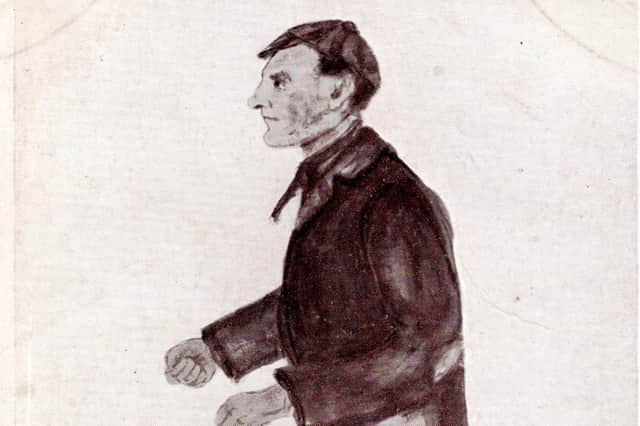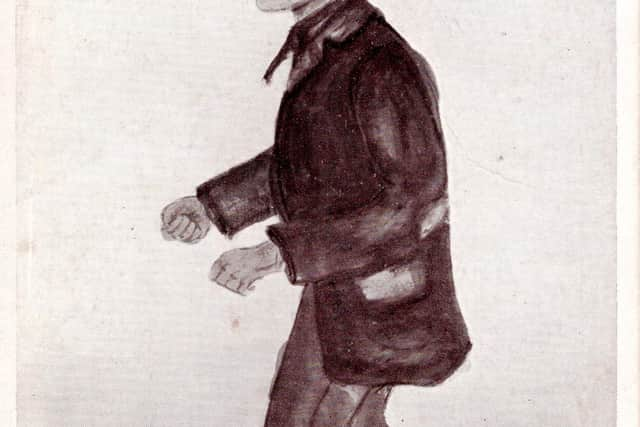Old Edinburgh Worthies 2: The violent, volatile and energetic Walking Dick


In his old age, Walking Dick was described as a tall, energetic fellow, with the appearance of a former soldier. He is said to have worked at a rubber factory while still young and agile, but only when he felt like it; his main interest in life, apart from drinking whisky, was pedestrianism.
Just for the fun of it, he would throw down his coat at Register House and compete with the Leith omnibus travelling up Leith Walk, with the impudent street urchins in hot pursuit, screaming, "Walking Dick!" and imitating his athletic mannerisms.
Advertisement
Hide AdAdvertisement
Hide AdIt was said that, "Every movement of his was made in a most masterly and sporting style, and although ‘a wee bit off’ was always regarded as ‘a good sport’.”In 1876 came Walking Dick’s first newsworthy exploit: a walking duel against the Londoner W Perkins. The outcome is not known.


Dick was described as a well-known Edinburgh street character. When he was drunk, Dick had a very short temper. In June 1876, he faced the Sheriff Criminal Court for assaulting the boy David Lisle: at the Fishmarket, he had kicked and beaten this impudent lad severely. For no apparent reason, he then beat up the widow Margaret Walker near the arch of the North British Railway bridge, Low Calton. Having several previous convictions for assault, he was sentenced to imprisonment for nine months.
In its report of the court proceedings, The Scotsman describes him as 'a young man named James Dick, better known in Edinburgh as Walking Dick.' The artist Ned Holt, who had a liking for Edinburgh outcasts, made a drawing of Walking Dick, and the poet Donald Campbell celebrated him in a felicitous poem:
From Bristo Square to Waterloo PlaceOr any challenge you might pick,He’ll surprise you with his pace,The way he covers ground so quick,No matter how poor the odds you getIt’s better to bet on Walking Dick
Advertisement
Hide AdAdvertisement
Hide AdSpending the remainder of 1876 and early 1877 in prison, Walking Dick was released to continue his life of pedestrianism and petty crime. In June 1877, he assaulted a publican in Leith Street and was rewarded with 15 more days in prison, with hard labour. In October 1878, he took part in a pedestrian event at the Royal Gymnasium in Edinburgh.
The following month, he was sentenced to ten days’ imprisonment after having been caught begging on top of a tramway car in Princes Street. Dick pleaded not guilty, saying that he had just asked 3d from his brother, to enable him to pay the fare to Portobello, but two policemen said they had often seen Dick begging on the tramcars at the Register House.
A few weeks later, he pleaded guilty to being riotous and disorderly in Castle Street and Princes Street, and being well known to the police, he was sentenced to 15 days’ imprisonment.
In October 1879, James Dick was convicted of begging and disorderly conduct in Leith Street, and being an old offender, he was sentenced to 30 days’ imprisonment.In June 1883, a labourer named James Dick was fined 10/- with the option of seven days imprisonment, for swearing in the Kirkgate, Leith, on June 8. He said that he was putting away boys who were calling him Walking Dick. In October the same year, he was sentenced to 20 days in prison for behaving riotously in Clyde Street.
Advertisement
Hide AdAdvertisement
Hide AdThis was the final newspaper mention of this extraordinary old Edinburgh character, however, and we can only speculate what happened to him in the end. If he died in the 1880s, he would hardly have been described as an old man in 1919. It may be presumed that he was born between 1845 and 1855, since he was described as a young man in 1876, while yet having several previous convictions.
Two James Dicks were born in the City of Edinburgh between 1840 and 1860, namely in 1858 and 1859, making them too young to appear in court in 1876. Thus it would appear that Walking Dick was born an out-of-towner, leaving far too many candidates to choose between. Likewise, it is strange that his newspaper appearances, common in the 1870s, suddenly cease after 1883, but no promising James Dick died in the Capital during the mid or late 1880s.
Wholly unimpeded by the genealogists, professional and amateur alike, James Dick walks off into the sunset; a spectral Edinburgh worthy.
Jan Bondeson is author of Phillimore's Edinburgh, published by Amberley Books and Murder Houses of Edinburgh
A message from the Editor:
Thank you for reading this article. We're more reliant on your support than ever as the shift in consumer habits brought about by coronavirus impacts our advertisers.
If you haven't already, please consider supporting our trusted, fact-checked journalism by taking out a digital subscription
Comment Guidelines
National World encourages reader discussion on our stories. User feedback, insights and back-and-forth exchanges add a rich layer of context to reporting. Please review our Community Guidelines before commenting.